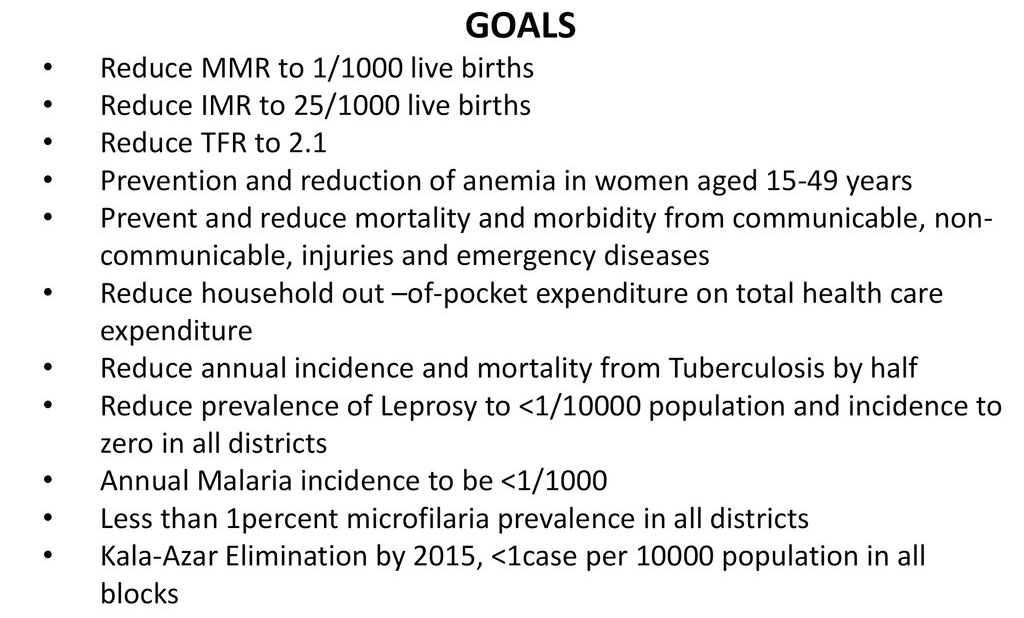National Health Mission | 21 Jul 2021
Why in News
Recently, the Union Minister of State for Health and Family Welfare informed the Rajya Sabha that National Health Mission (NHM) supported health system reforms have resulted in development of resilient health systems.
Key Points
- About:
- NHM was launched by the government of India in 2013 subsuming the National Rural Health Mission (Launched in 2005) and the National Urban Health Mission (Launched in 2013).
- The main programmatic components include Health System Strengthening in rural and urban areas for - Reproductive-Maternal- Neonatal-Child and Adolescent Health (RMNCH+A), and Communicable and Non-Communicable Diseases.
- The NHM envisages achievement of universal access to equitable, affordable & quality health care services that are accountable and responsive to people's needs.
- Support to States & Union Territories (UT):
- Health Facilities:
- NHM support is provided to States/UTs for setting up of new facilities as per norms and upgradation of existing facilities for bridging the infrastructure gaps based on the requirement posed by them.
- Health Services:
- NHM support is also provided for provision of a range of free services related to maternal health, child health, adolescent health, family planning, universal immunisation programme, and for major diseases such as Tuberculosis, vector borne diseases like Malaria, Dengue and Kala Azar, Leprosy etc.
- Health Facilities:
- Major Initiatives Supported Under NHM:
- Janani Shishu Suraksha Karyakram (JSSK).
- Rashtriya Bal Swasthya Karyakram (RBSK).
- Implementation of Free Drugs and Free Diagnostics Service Initiatives.
- PM National Dialysis Programme.
- Implementation of National Quality Assurance Framework in all public health facilities.
- Mobile Medical Units (MMUs) & Tele-consultation services are also being implemented to improve access to healthcare particularly in rural areas.
- Ayushman Bharat.
- Pradhan Mantri Jan Arogya Yojana (AB-PMJAY).
Achievements of NHM
- Improvement in Health Indicators:
- In the 15 years of implementation, the NHM has enabled achievement of the Millennium Development Goals (MDGs) for health.
- The MDGs have been superseded by the Sustainable Development Goals.
- It has also led to significant improvements in maternal, new-born, and child health indicators, particularly for maternal mortality ratio, infant and under five mortality rates, wherein the rates of decline in India are much higher than the global averages and these declines have accelerated during the period of implementation of NHM.
- In the 15 years of implementation, the NHM has enabled achievement of the Millennium Development Goals (MDGs) for health.
- Growth in Public Health Facilities:
- NHM adopts a health system approach and targets to build a network for public health facilities with Health & Wellness Centres at the grassroot level and District Hospitals, with robust referral linkage, to offer Comprehensive primary and secondary care services to citizens.
- NHM has not only contributed to increase in the institutional capacities for service delivery but also has led to development of capacities for targeted interventions of the various National Programmes under the NHM.
- Equitable Development:
- There was also a sustained focus on the health of tribal populations, those in Left Wing Extremism areas, and the urban poor.
- A more recent effort at ensuring equity in access and use, is the Aspirational district initiative, in which 115 districts across 28 states, with weak social and human development indicators have been identified for allocation of additional resources and capacity enhancement to catch up with more progressive districts.
- National Ambulance Services:
- At the time of launch of NRHM (2005), ambulance networks were non-existent.
- So far, 20,990 Emergency Response Service Vehicles are operational under NRHM.
- Besides 5,499 patient transport vehicles are also deployed, particularly for providing “free pickup and drop back” facilities to pregnant women and sick infants.
- Human Resource Augmentation:
- NHM supports states for engaging service delivery HR such as doctors, nurses and health workers and also implements the world’s largest community health volunteer programme through the Accredited Social Health Activists (ASHAs).
- More than 10 lakhs ASHAs and ASHA facilitators are engaged under NHM.
- NHM has also supported states to acquire staff with skills in public health, finance, planning and management to plan and implement interventions, freeing up clinical staff to deliver health services.
- NHM supports states for engaging service delivery HR such as doctors, nurses and health workers and also implements the world’s largest community health volunteer programme through the Accredited Social Health Activists (ASHAs).
- Health Sector Reforms:
- NHM enabled the design and implementation of reforms specifically related to Governance, Procurement and Technology.
- Addressing high Out-of-Pocket Expenditure (OOPE):
- Recognising the need for reducing the current high levels of OOPE, and that, almost 70% of the OOPE is on account of drugs and diagnostics, the Free Drugs and Free Diagnostics Services Initiatives have been implemented under the NHM.
- The National List of Essential Medicines (NLEM) and the Essential Diagnostics Lists have been notified and are periodically updated to include more essential drugs based on new initiatives undertaken.

